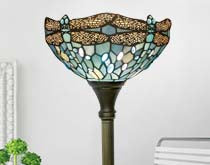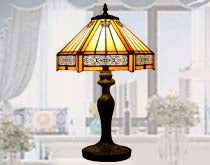What is so special about Tiffany glass?
As you stood there, gazing at the Tiffany style lamp, your mind was probably filled with wonder.
What was the journey behind that glass to become what it is now? What are the stories and history it holds? Next, let's explore the mystery behind it.
Related reading: Are Tiffany-style lamps out of style?

The Origin of Tiffany Glass
The origins of Tiffany glass trace back to the late 19th century, pioneered by the American artist and designer, Louis Comfort Tiffany.
After countless trials and refinements, he and his craftsmen succeeded in introducing a unique glassmaking process named Favrile glass, meaning handmade.
However, making Favrile glass requires precise temperature control and expertise to produce stunning results. The journey of Tiffany lamps to fame wasn't smooth sailing.
Moreover, Tiffany's creations face skepticism—doubts over the technique, the longevity and practicality of the glass, and the design aesthetics.
Types of Tiffany Glass
The brilliance of Tiffany glass is not only the surface of our recognition, a lamp can not see all the Tiffany glass types, Tiffany glass types contain a lot, which is its greater value than one of the collection of points!
Opalescent Glass
This is where the magic begins. Opalescent glass merges a spectrum of colors, conjuring an ethereal, dreamlike effect. It's akin to capturing the first rays of dawn or hues of the twilight sky within the confines of glass.
Favrile Glass
The uniqueness of Favrile Glass lies in its hues and textures. Unlike traditional stained glass, the colors in Favrile glass are introduced during the melting process, not painted on afterward.
This ensures that each piece of Favrile glass boasts its distinct colors and patterns, rendering each a one-of-a-kind masterpiece.

Copper Foil Technique
Traditional stained glass is held together with lead, which has its limitations.
The copper foil technique was originated by Louis Comfort Tiffany and is a departure from the traditional glass-making process.
Traditional stained glass windows tend to use strips of lead to connect the individual glass segments, but this method has design limitations, especially for complex and delicate patterns.
Tiffany's copper foil technique, on the other hand, uses thin strips of copper tape to wrap around the edges of the glass segments and then joins them together through soldering.
This method not only offers greater design flexibility but also allows for finer and more intricate pattern-making. As a result, Tiffany's innovative technique has enabled the design and production of glass artwork to reach new heights.
Streamer Glass
As the name suggests, this type of glass captures the essence of natural elements, such as the gentle flow of streams or the delicate trail of a shooting star. The textured patterns seem to be in perpetual motion, bringing vitality to any piece.
Fracture Glass
Imagine looking through the canopy of a forest, with distant leaves shimmering in the sunlight. Fracture glass captures this distant, fragmented vista, adding depth and perspective to designs.
Fracture-Streamer Glass
This type of glass harmoniously blends streamers and fractures, creating a symphony of textures. It's like capturing the rustling of leaves and the flow of a river in a single frame.
Ring Mottle Glass
A creation from the early 20th century, this type of glass features a range of designs, from floral patterns to abstract designs. It's where art meets glass.
Ripple Glass
Ripple glass evokes images of gentle ripples on a tranquil pond or the intricate textures of leaves, aiming to capture the subtleties of nature. It serves as a reminder of the beauty in detail.
Drapery Glass
Drapery glass is the showstopper, with its heavily folded texture mimicking the elegant folds of fabric. It's not just glass; it allows us to experience the finesse and delicacy of art.

What is Stained Glass?
Stained glass is achieved by adding specific metal oxides or minerals to the glass furnace. For instance, adding copper or gold can produce red, while adding iron can yield green or blue.
This glass retains its color after cooling and doesn't fade or change. Stained glass is often combined with other techniques, like the lead came technique, where colored glass fragments are held together by lead strips, forming intricate patterns or images.
In Conclusion
After delving deep into the making of Tiffany glass, do you find a newfound respect for the Tiffany-styled lamp in your hands? However, the real allure lies in the fact that whether it's authentic Tiffany glass or a Tiffany-styled design, both cater to people's pursuit and admiration for beauty in their own unique ways.
Related reading: Tiffany Lamp vs Tiffany Style Lamp























